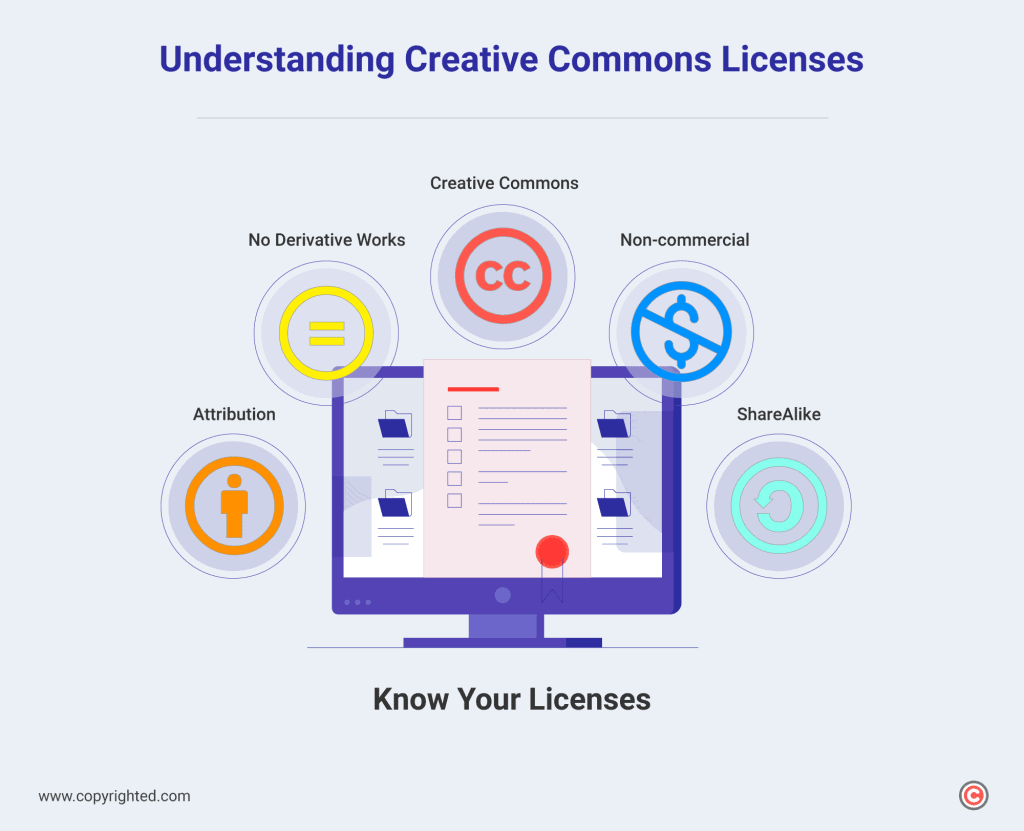Creators and users operating in the digital space adhere to principles of copyright and fair use, shaping the landscape through considerations of ownership, usage, and ethical engagement.
As creators bring their ideas to life and users engage with various content, grasping the concepts of copyright and fair use becomes more important.
This article explores why understanding copyright and fair use goes beyond just obeying the law. It acts as a guide for creators and users, making sure everyone gets along within the rules of intellectual property.
Let’s explore why these rules are important and how they influence the world of digital creation and sharing.
- A solid understanding of copyright and fair use enables creators to protect their work, ensuring due credit and preserving the integrity of their intellectual creations.
- Fair use isn’t a one-size-fits-all rule. It’s a tricky concept and its application varies across different situations.
- Creative Commons licenses offer different permissions, some allowing commercial use while others do not.
Table of Contents
Why is It Important to Understand Copyright and Fair Use?
Understanding copyright and fair use is important because it’s a protection for both creators and users in the vast realm of digital content. I’m not just talking about legality here, being aware of the concepts of copyright and fair use is the cornerstone for respectful and responsible content creation.
For creators, a solid understanding of copyright and fair use allows them to protect their work.
Meanwhile, for content users, knowledge of copyright and fair use serves as a guide for responsible content creation, steering individuals away from unintentional infringements and promoting ethical conduct in the digital realm.
Understanding copyright laws acts as a shield against legal consequences, protecting individuals and businesses from potential complications stemming from unauthorized use of copyrighted material.
In the era of digital sharing, a comprehensive understanding of copyright and fair use encourages respect for the rights of creators and contributors, building a digital environment built on integrity.
In educational settings, a grasp of copyright and fair use is important for students and educators, providing a framework for responsible research, teaching, and learning. A question that frequently arises in these settings is: if something is copyrighted how can it be used? The answer lies in a thoughtful understanding of fair use, licensing, and permissions.
In essence, a profound understanding of copyright and fair use goes beyond legal compliance, it promotes respect, responsibility, and innovations in our digital interactions.
This knowledge benefits both creators and consumers in the ever-evolving landscape of intellectual property.
Why is It Important for Students to Learn About Copyright and Fair Use?

It’s very important for students to learn about copyright and fair use because it extends beyond the academic realm, it impacts a student’s professional path. A solid grasp of these principles acts as protection from legal issues in education and career pursuits.
In today’s world of easy information access and widespread sharing, not knowing copyright laws isn’t a reliable defense against potential legal pitfalls.
Teaching students the basics of copyright and fair use gives them the tools to understand intellectual property.
This knowledge protects them from unintentional legal issues and encourages responsible content creation. It empowers students to engage with intellectual property ethically and legally in their academic and professional pursuits.
Understanding copyright and fair use practically enables students to use resources, conduct research, and contribute to academic discussions without accidentally breaking the law.
It encourages students to be responsible digital citizens who value both their own creativity and the work of others.
Additionally, as students enter professional roles, knowing about copyright and fair use becomes an even more so important asset.
Whether creating content, working with others, or using digital platforms, this knowledge helps them make decisions about their work that follow legal and ethical standards.
Learning about copyright and fair use is not just theoretical, it’s a practical and essential skill. It helps students handle both academic and professional situations responsibly, ethically, and legally.
7 General Things to Know about Copyright and Fair Use
Whether you’re creating content, writing a research paper, collaborating with others, or engaging with digital platforms, the knowledge of copyright and fair use serves as a foundation for making informed and lawful choices.
To enhance understanding and management of these principles, here are seven key aspects regarding copyright and fair use I would recommend you keep in mind:
The Basics Matter
Copyright protection is automatically granted when an original work is brought into tangible existence, and there’s no requirement for formal registration. That doodle you created last night is already protected under copyright law.
Unlike other forms of intellectual property, such as patents or trademarks, there’s no need for formal registration, the protection is inherent.
In this context, it’s vital to uphold the principle of reciprocity – respecting others’ rights as you would want yours to be respected.
Fair Use isn’t One-Size-Fits-All
Fair use is a tricky and complicated concept, and its application varies across different situations.
Various factors such as purpose, nature, amount, and market impact contribute to determining the fairness of a particular use.
Context also matters significantly, so it’s essential to avoid making assumptions and instead assess each situation individually to gauge the applicability of fair use principles.
One important aspect to keep in mind is the notion of transformative use.
Fair use often comes into play when the original work is transformed significantly, resulting in a new creation with a different purpose or meaning.
This transformative aspect can strengthen the argument for fair use, emphasizing the creative and innovative nature of the new work.
Creative Commons Doesn’t Mean Free-for-All
Creative Commons licenses offer different permissions, some allowing commercial use while others do not. It’s important to understand the specifics of each license type.
Always read and respect the terms outlined in Creative Commons licenses. These licenses are not a blank check for unrestricted use, rather, they come with specific conditions that should be adhered to for ethical and legal use.
Consequences of Copyright Infringement
Using copyrighted material without permission can lead to significant consequences, potentially leading to severe fines and legal troubles. The implications of copyright infringement are not to be taken lightly, as they extend beyond mere financial penalties.
Infringing on someone’s copyright can lead to reputational damage and strained professional relationships.
When legal action is taken, the consequences might include court-ordered injunctions, demanding the immediate cessation of unauthorized use, and the potential obligation to compensate the copyright owner for damages incurred.
Prevention is key to avoiding these repercussions, and exercising caution in your use of copyrighted material can save you from unnecessary legal headaches.
Not Everything Online is Free to Use
Public domain refers to creative works whose copyright has expired, been forfeited, or is otherwise freely available for use by the public.
Works in the public domain are not subject to copyright restrictions, allowing anyone to use, modify, and distribute them without seeking permission from the original creator.
However, you need to be careful here. Just because something is available online doesn’t automatically mean it’s free to use.
Determining whether a work is in the public domain requires diligent research. Look for clear indicators of public domain status to ensure that you don’t unintentionally infringe on copyright when using online material.
How to Use Content Without Headaches
To use copyrighted content without legal issues, taking a proactive approach is important.
When considering the use of copyrighted material, obtaining permission from the copyright holder is a fundamental step. This may involve reaching out directly to the creator, author, or copyright owner to request the necessary permissions.
You can also opt for public domain works, being free from copyright restrictions, they offer a hassle-free option for content use. However, it’s important to confirm the public domain status through diligent research.
Additionally, content under a valid license provides a clear framework for legal use. Whether through Creative Commons licenses or other licensing agreements, adhering to the specified terms ensures that you stay within legal boundaries.
Don’t forget that keeping detailed records of your efforts to obtain permissions or your confirmation of a work’s public domain status is an essential part of responsible content use.
Educational Use Has Limits
While educational use enjoys some flexibility, it’s not an all-encompassing exemption from copyright regulations. The purpose, nature, and amount of material used still matter.
Exercise caution in educational settings and don’t assume complete immunity when using copyrighted content for educational purposes. Understanding the limitations ensures responsible engagement with intellectual property in academic contexts.
Frequently Asked Questions
What are the consequences of using copyrighted material without permission?
The consequences of using copyrighted material without permission can range from legal action to financial penalties.
How can you determine if a work is in the public domain and free to use?
Look for clear indicators like expired copyright, public domain dedications, or works explicitly labeled as such. When in doubt, it’s better to err on the side of caution.
What steps can you take to protect yourself legally when using copyrighted content?
Seek permission from the copyright holder, use licensed content, or opt for public domain material. Document your efforts, and you’ll have a strong defense if any legal issues arise.
How do licenses and terms impact the use of copyrighted material?
Licenses and terms dictate how you can use, share, and modify the copyrighted work.
Can you use copyrighted material for educational purposes without permission?
Yes, but within limits. The purpose, nature, and amount of material used still matter. Be mindful and ensure your use falls within the boundaries of fair use for education.


